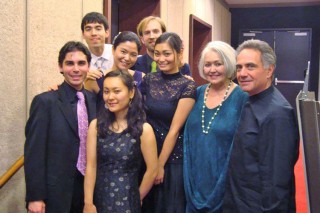Title

Collaborative Piano students and staff. From left: Julius Abrahams (MM '12), Arthur Williford (MM '14), Young Ji Kim (MM '12), Nozomi Marusawa (MM '12), Dan K. Kurland (MM '13), Maiko Nishio (MM '12); and faculty members Margo Garrett and Jonathan Feldman
(Photo by Nozomi Marusawa)Being a collaborative pianist is, by definition, all about working with other musicians, but what would it mean for collaborative pianists to work with each other? That question intrigued the tight-knit group of seven musicians who entered Juilliard’s program in 2010. A year later, they decided that it might be fun to perform a duo-piano concert, and it was such a success that they’re doing the same thing on September 26. In the spirit of collaboration, we asked two of the participants, D.M.A. student Dan Kurland (M.M. ’13) and faculty member and collaborative piano department chair Jonathan Feldman (Pre-College ’69; B.M. ’75, piano) a few questions about working with other pianists and the origins of the concert’s intriguing name: Round Two: A Concert of Dual-ing Pianists. Also performing will be the 11 other returning students as well as faculty members Margo Garrett and Brian Zeger (M.M. ’81, piano).
Body
What was the original impetus for the Dual-ing Pianos concert?
Dan Kurland: I entered the collaborative piano department in 2010 with six colleagues, and we became very close and really formed a little family. At the end of our first year, we decided it would be fun to perform in a duo piano concert and we invited our faculty to join us. We know how busy the school year can get, so we all worked to create a program and assigned music in May so that we could have the concert early in the school year, and it was a nice welcome back from summer into the new school year.
Can you explain the name?
DK: It features faculty and students in the collaborative piano department, but simply calling it a department concert seemed a little uninteresting, so we decided on a name that provides a context for the evening.
Jonathan Feldman: There was some faculty grumbling that “dueling” was too combative a description for the event. It was then determined that, in the spirit of collaboration, “dual-ing” was more acceptable.
What can we expect to hear?
JF: Margo Garrett and I will reprise our duo chops this year again. It’s always a pleasure to work with her in any capacity, and I look forward to it immensely!
DK: We’ll open the evening with the only four-hand piece on the program, by Schubert, then move to a diverse spread of works by Mozart, Schumann, Lutoslawski, Copland, Milhaud—and a surprise ender by Bizet.
How does playing with another pianist differ from playing with an instrumentalist or vocalist—and what can be learned from the experience?
JF: The training for our students is primarily to study the repertoire we play with other instrumentalists and vocalists. Playing with other pianists raises other issues. When two play on one piano, only one can use the pedals—it’s very difficult to pedal for someone else. Can you imagine a string player bow while you finger or a wind player while someone else pushes the buttons? Also, as the music is sometimes written in ways that make us intertwine arms, we’d better be friends. And while playing on two pianos, ensemble is a big concern as we face each other and can’t watch each other’s hands—we must rely on head gestures and radar as our collaborative cues.
Plus, playing with a different instrument or voice is easier from a textural standpoint. When the only sounds you hear are from the pianos, we all must be extremely careful that line, balance, and pedal be more deliberate and clear. And that’s also extremely beneficial for our work with instruments and voice.
DK: In 2011, we learned a lot! Playing with another pianist in two-piano repertoire has challenges that one doesn’t encounter with almost any other collaborator; because the pianos are placed end-to-end, you can’t see your partner prepare to begin playing as you do with other instrumental partners (such as watching a bow or the end of a flute).
Also, a singer is generally just a few feet away when you’re performing together, so it’s easy to hear his or her breath, whereas another pianist is at the other end of the stage. These were wonderful challenges to encounter, and they forced us to heighten our listening, think about cueing and timing our sound, and keep very steady rhythm. It brought a renewed perspective to our future work with non-pianists.
Is there anything that’s changing based on the previous concert?
JF: The only things we’re changing are personnel and repertoire. Dan helped organize this the first time and has taken it on again. We’re hopeful that it will be as successful the second time (no pressure, Dan…).




